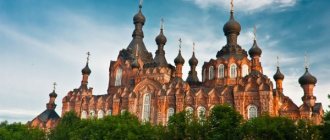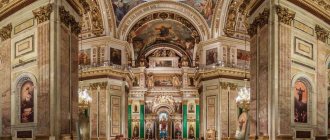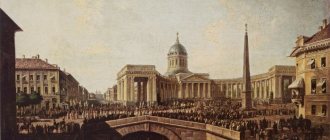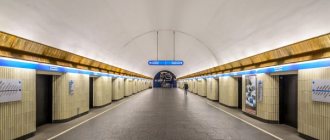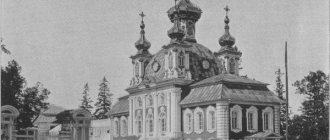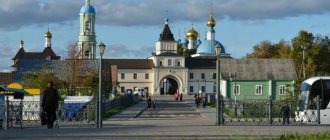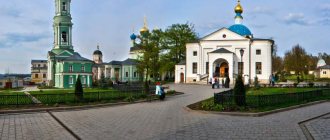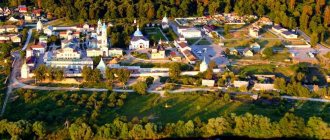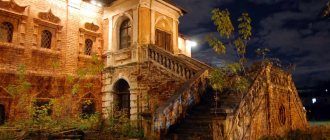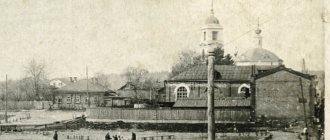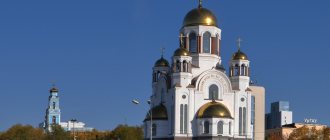The beautiful temple on Vasilyevsky Island attracts attention with its majesty and beauty. Monastery farmsteads have long been located here, and today Optina Pustyn, a farmstead in St. Petersburg, is located here. Pilgrims, clergy, and tourists come here to touch the shrines and feel the powerful atmosphere of conciliarity and faith.
Optina Pustyn Monastery
Back in the 15th century, a monastery was formed near Kozelsk - Optina Pustyn. It is known that the monastery was founded by a certain group of hermits, but the first years of the monastery’s history are poorly studied. This territory was disputed for a long time and passed from hand to hand. Only at the end of the 18th century did the real formation of the monastery begin. The monastery became a real spiritual center, many books and icons were born here, pilgrims flocked here to receive help in faith and an impulse to a virtuous life. The monastery has always been known for its care for the poor and sick. In the 19th century, such prominent thinkers as F. M. Dostoevsky, Vl. Soloviev, K. Leontyev, L.N. Tolstoy visited here three times. Many clergy found their calling here, including Pavel Florensky. In 1987, the monastery experienced its rebirth after decades of oblivion during the Soviet era. The monastery is restoring its former significance and expanding, which is why the idea arose to open a new place - a metochion in St. Petersburg.
The idea of opening a Compound
A metochion is a kind of branch of a monastery, which is located far from the main monastery. Typically, deserts were created to accommodate pilgrims and priests, as well as to solve various administrative and economic problems. Optina Pustyn (a metochion in St. Petersburg) was needed so that priests and elders from the monastery could stay in the city during their trips on various issues. Even before the revolution, the monastic authorities were considering opening a desert in the capital, St. Petersburg, but the coup prevented these plans from being realized. In 1999, Archimandrite Evlogii, the abbot of the monastery, turned to the administration of St. Petersburg with a request to allocate a church to house the monastery courtyard. This was a time of active return of cathedrals to the control of the church, and the idea was received quite favorably. So it was announced that Optina Pustyn - a courtyard (St. Petersburg) would appear.
Revolutionary and Soviet years in the life of the courtyard
Services were held daily in the temple, a large library worked, and the monks carried out their obedience within the walls of the monastery. But the revolution of 1917 broke out and the quiet life of the monks and parishioners ceased.
At first the courtyard acquired the status of a parish church. In the 1920s, all valuables were removed from the temple. The authorities have repeatedly attempted to close the church. They wanted to transfer the building to the management, but the transfer did not take place. Later it was decided to demolish the building. Parishioners collected more than three thousand signatures in defense of the temple. The arrest of the monks remaining at the temple and a number of activists from among the parishioners followed. Among those exiled to Solovki was the choir singer Mikhail Vasilyevich Gundyaev, the father of the current Patriarch Kirill.
In 1935, the temple was closed and a warehouse was built in it. In 1961, a skating rink with an artificial ice surface was built here. The priceless paintings on the walls were simply painted over. Exposure to prolonged cold and moisture destroyed the walls and foundation of the historical structure.
History of discovery
The authorities of St. Petersburg offered the governor several options for consideration, and his gaze settled on an ancient place of prayer on Vasilievsky Island, where the Kiev-Pechersk courtyard was once located. When representatives of the monastery walked around the territory of the former metochion, they became despondent - the condition of the buildings was appalling. In Soviet times, a public skating rink was located here, where the famous Leningrad figure skating school was born and went through its stages of formation and takeoff. Due to constant dampness, the buildings quickly deteriorated and required urgent repairs. The monks were no strangers to struggling with difficulties, and they actively began to restore the farmstead, attracting parishioners and donors. Today the question is: “Optina Pustyn, courtyard in St. Petersburg - how to get there?” has ceased to cause bewilderment, and every resident of the city knows that the beautiful temple above the Neva is the courtyard of the famous monastery.
Novodevichy Cemetery
Four years before the start of construction of the monastery, a place was allocated for the burial of people, which in our time is called the Novodevichy cemetery. When a site was allocated for the monastery building, the cemetery automatically became the property of the Orthodox community. In the first years of its existence, the cemetery was very small; few people were buried here. When it was transferred to the monastery department, it began to grow and become popular. Only representatives of the noble classes began to be buried here.
From 1845 to 1934, about 25,000 people were buried at the Novodevichy cemetery. Most of the burials were not preserved; only a few monuments remained, which vandals could not find use for.
Many famous people of Russia are buried at Novodevichy Cemetery: artists, poets, doctors, architects. It was popular among the St. Petersburg nobility and merchants. Thanks to this, many highly artistic sculptural monuments were installed in the cemetery.
After the revolution, most of the relatives whose loved ones were buried in the cemetery immigrated abroad, and there was no one to look after the burials. Rich graves became a good bait for atheists. During the times of general persecution and ban on the Orthodox faith in the post-revolutionary period, many burial places were looted and completely destroyed. The chapels and temples located at the cemetery were demolished.
At the beginning of the 21st century, the city committee for the protection of monuments collected archives of old documents and restored the names of 13,730 people buried at the Novodevichy cemetery.
Compound today
Optina Pustyn (a courtyard in St. Petersburg), photos of which can be seen in many guidebooks because of its beauty and historical significance of the place, today is a well-functioning enterprise. On the territory of the courtyard, the majestic Church of the Assumption of the Blessed Virgin Mary was restored, which survived a very difficult and long restoration. Today, religious services are held here every day. Services are often conducted by the country's leading clergy. Numerous buildings have also been partially restored and partially rebuilt. At the courtyard there is a Sunday school, a gymnasium, an Orthodox Institute of Religious Studies and Church Arts, and a gold-embroidery workshop “Ubrus”. It has its own men's choir and a pilgrimage center with a hotel and cafe. The courtyard hosts a lot of different events: meetings, discussions, concerts. This is a real spiritual and educational center. The pilgrim conducts excursions around the territory of the monastery, the Church of the Assumption of the Virgin Mary, St. Petersburg and its suburbs, and organizes trips to holy places. In 1999, a country residence was opened in the desert in the village of Sosnovy Bor, Vyborg region.
Large farm
The residents of the monastery work every day to provide the household with food. The small cheese factory produces the freshest cheese from goat and cow milk. Tomatoes, cucumbers and even strawberries grow in the spacious greenhouse. Thanks to careful care of the garden, it is possible to obtain quite exotic fruits, such as avocados.
During the excursions, visitors are told many interesting facts related to the history of the monastery, the courtyard and the life of the monks themselves. Guests visit the most picturesque places of the estate. The grocery store at the entrance sells the freshest products: honey, pastries, home-made cheese, as well as ostrich eggs and feathers. You can purchase souvenirs, spiritual literature and church utensils. The benefits of visiting the courtyard are obvious. Communication with nature and God gives a lot of strength, energy and health.
Temple in honor of the Dormition of the Blessed Virgin Mary
Optina Pustyn (a courtyard in St. Petersburg) was built around the Church of the Assumption of the Blessed Virgin Mary. The church was erected by the Kiev-Pechersk courtyard at the end of the 19th century. Another temple previously existed on this site, which was moved to the Fontanka embankment. The church is made in pseudo-Russian style, its walls are lined with stone on the outside - granite and sandstone, and inside they are painted by Moscow artists Snegirev, Yakovlev and Strunnikov. The outside of the temple is also decorated with mosaics from the workshop of V. A. Frolov. The church contains a number of valuable icons with particles of the relics of the Optina elders and healers. The beauty of the services in the cathedral is emphasized and enhanced by the singing of the male choir of the courtyard.
Monastic churches
When the construction of the monastery ensemble was completed, there were seven working parishes in it: the Ascension Cathedral, the Kazan and Athos churches, the temple of St. Isidore Pelusiot at the bell tower, the Church of the Three Saints and two churches at the cemetery: Sorrowful and Prophet Elijah.
Resurrection Cathedral
The main attraction of the monastery ensemble is the Resurrection Cathedral. The five-domed, two-story temple was built in the Russian-Byzantine style and resembles church buildings of the 15th century. At its highest point, the height of the cathedral is 50 meters.
Construction of the cathedral lasted from 1849 to 1861 according to the design of the architect Nikolai Efimov. A high arched portal crowns the main entrance of the temple, facing Moskovsky Avenue. The columns, united in two, support the decorative arcades that decorate the façade on the north and south sides. On the elongated drums there are five onion-shaped domes covered with golden scales. Bell towers were located under four small domes. The drums in a circle are decorated with an arcade of arched openings; through one they are blind.
After the construction of the cathedral, a very beautiful semicircular iconostasis in five tiers was installed here. The walls, vault and images of the temple were painted by nuns and painters of the monastery. Abbess Feofanya personally painted the image of the Smolensk Mother of God Hodegetria, which was considered miraculous and is located in the Assumption chapel.
There are five chapels in the Resurrection Cathedral. The main one is consecrated in memory of the Resurrection of Christ, the left one - in memory of Michael the Archangel, the right one - in the name of the Dormition of the Virgin Mary. Two chapels are located in the choir. The left one is consecrated in memory of St. Nicholas the Wonderworker, the one on the left is in the name of All Saints.
Another chapel was built in 1874-1875. in the basement of the Resurrection Church. A special project for it was developed by the architect Grigory Karpov. The chapel was consecrated in honor of Theodosius of Pechersk and Gregory of Neocaesarea.
Cell churches
On the southern and northern sides of the Resurrection Cathedral, two identical churches are located symmetrically, separated from the central temple by monastic buildings. On the north side there is the Church of the Three Ecumenical Hierarchs, on the south - the Church of Athos.
Both temples were built according to the design of the architects N. E. Efimov and N. A Sychev. On July 10, 1850, the foundation stone of the Athos Church took place. Construction lasted four years. On July 28, 1854, the consecration of the temple took place in memory of the icon of the Athos Mother of God. The solemn ceremony was attended by Princess Maria Nikolaevna, daughter of Nicholas I. The iconostasis for the temple was made by the architect of the sovereign's court, A. I. Stackenschneider.
On the north side, in the hospital building, the Church of the Three Saints was founded, in appearance no different from the Church of Athos. Both churches were founded in the same year, only the second one took a year longer to build. In 1855 the consecration of the temple took place. In the Church of the Three Saints, the image of the Mother of God “Fragrant Flower” was kept, for which the nuns especially loved to visit it.
Both temples have five gilded domes and a tent-shaped bell tower. An altar apse is attached to each church on the eastern side. The hipped roof is painted green and ends with a gilded onion dome. Semicircular zakomaras complete the upper part of the façade. The front facade is decorated with arches. Each side of the tent has narrow dormer windows.
Cemetery Church of Elijah the Prophet
The stone Church of Elijah the Prophet in the Moscow style was located at the entrance to the cemetery. The project for the church was developed by the architect L. N. Benois. Construction ended in 1888. It was a temple with five onion domes, decorated with glazed brick. The zakomaras, pointed at the top, were located above the eaves of the building. The interior decoration of the church was rich. The carved oak iconostasis especially stood out. Church utensils were purchased from the best jewelry stores in St. Petersburg. In 1925, the temple was closed by the Soviet authorities. Unfortunately, the Church of Elijah the Prophet did not survive to this day; it was dismantled into bricks in 1930.
Cemetery Sorrow Church
In the center of the Novodevichy cemetery in 1856, the Church of the Icon of the Mother of God was erected. It received the second name “Karamzinskaya” because it was built over the grave of the son of the writer N.M. Karamzin, the famous commander of the hussar regiment. When his wife died, she was buried next to the new temple. The Sorrow Church was famous for one of the most beautiful icons in St. Petersburg - the image of the Resurrection of Christ, carved from ivory. In 1925, the cemetery church was closed, and five years later it was demolished. The Karamzins' grave was also destroyed.
Kazan Church
The Kazan Church became the first temple built in the Novodevichy Convent. Initially it was a wooden building, built according to the design of architect N. E. Efimov. Construction of the temple did not last long: from September 23 to October 22, 1848. Bishop Nathanael of Revel performed the solemn consecration. In 1869, a crypt was built under the church, building a stone foundation. At the same time, the building was slightly renovated. High-ranking church people were buried in the crypt. After burial, a tombstone was installed in the floor of the temple.
With the increase in the number of parishioners, the wooden church began to seem cramped, and a decision was made to build a stone church. Its laying took place on June 21, 1908 and was consecrated by Metropolitan Anthony. The building project was developed by architect Vasily Kosyakov. Construction lasted 4 years. Part of the funds for the construction of the temple was allocated from the monastery treasury, the missing amount was donated by local merchants Kashintsev and Panteleev.
The temple was built in the neo-Byzantine style and is vaguely similar to the Hagia Sophia in Constantinople. Low drums, surrounded by arcade windows, are crowned with trimmed domes. Initially, special tiles from Greece were ordered for the dome covering. Unfortunately, during the years of Soviet power it was destroyed and during the restoration of the dome they were covered with copper sheets. Massive pylons with vaults decorated with carvings form portals containing entrances to the building. Each portal ends with a semicircular roof with a window in the form of a semicircle. Large semicircular windows fit harmoniously into the overall appearance of the building. Three apses adjoin the façade on the east side. A drum is built above the central one, ending with a dome. The elongated windows of the drum surround it in a circle. The upper part of the drum is decorated with mosaics in blue tones.
The interior decoration of the Kazan Cathedral is made in Russian style. The walls and vaults were painted by artist Foma Railyan. Most of the drawings made in tempera have survived to this day. Unfortunately, due to a lack of money during the First World War, work was stopped in 1915 and the painting of the walls was not completed. The central part of the cathedral is surrounded by massive columns, forming a rotunda. The round supports are made of red marble and decorated with golden capitals. The main chapel of the temple is located in the central hall. Two side chapels are adjacent to the main altar with iconostasis, and it turns out that they are, as it were, located in different rooms. The choirs are made under small domes. The central altar has a two-tier iconostasis, the side ones are single-tiered. All of them are decorated with gilding, including icon cases. To the left of the altar is kept a particle of the relics of St. Hilarion, located in a shrine.
The Kazan Church has basements in which a two-tier crypt was built. About 350 people are buried there. In front of the western facade of the building there are graves that have survived to this day. These include the burial places of Archimandrite Kirill (Nachis) and architect V. A. Kosyakov.
When the construction of the temple was completed, the consecration could not be carried out. In 1923, the Bolsheviks made their first attempt to close the church, but it was unsuccessful. In 1929, the Kazan Church was finally closed, and the building began to be used as a warehouse. In the post-war period, a machine-building workshop was set up here. The 50s could have been fatal for the temple. The authorities decided to blow up the building, and preparatory work was already underway. But for some technical reasons the bombers had to abandon their intention.
In 1989, the temple was transferred to the foreign parish of the Russian Church. In 1992, for the first time during the existence of the cathedral, a chapel in the name of the Mother of God was consecrated. Around the same years, the Novodevichy Convent began to be restored, and the church was handed over to its previous owners. From 2002 to 2004, restoration work was carried out on the Kazan Church.
Monastery bell tower
The monastery bell tower in four tiers was erected not far from the Resurrection Cathedral in 1895 and was called St. Isidore. Outwardly, it is similar to the Kremlin Bell Tower of Ivan the Great in Moscow.
A through arched passage through the first tier served as the main entrance to the nunnery. In the second tier, the church of St. Isidore Pelusiot was built, who was the heavenly patron of Metropolitan Isidore, the leading member of the Holy Synod, who died three years before the completion of the bell tower. Among the monastery servants, the church was also called the gate church. The third and fourth tiers contained bell towers. Corresponding to the uniform style of the monastery ensemble, the two upper tiers of the bell tower were surrounded by an arcade of arched recesses, in which a through opening was made through one. A large onion dome harmoniously completed the structure.
When the reconstruction of the streets of St. Petersburg began after the revolution, the bell tower was demolished in 1920, making a roadway in this place.
Country estate of the courtyard
In 1999, Optina Pustyn (a farmstead in St. Petersburg), whose address - Lieutenant Schmidt embankment, 27/2 - is now well known to everyone, received a plot of 40 hectares near the village of Sosnovy Bor in the Leningrad region. These lands were intended for the creation of a monastery and farming. The monks cleared the territory and created a large livestock complex, in which, in addition to cows, pigs and goats, even raccoons and ostriches live. On the territory of the country estate there is a pond in which novices breed Japanese carp. In 2006, a temple was founded in honor of the Holy Venerable Ambrose of Optina; it was consecrated in 2016. The monks also restored the Temple in honor of the Holy Blessed Grand Duke Alexander Nevsky, which was located near the village of Sosnovy Bor and had not been used for its intended purpose since Soviet times. Now regular services are held there.
